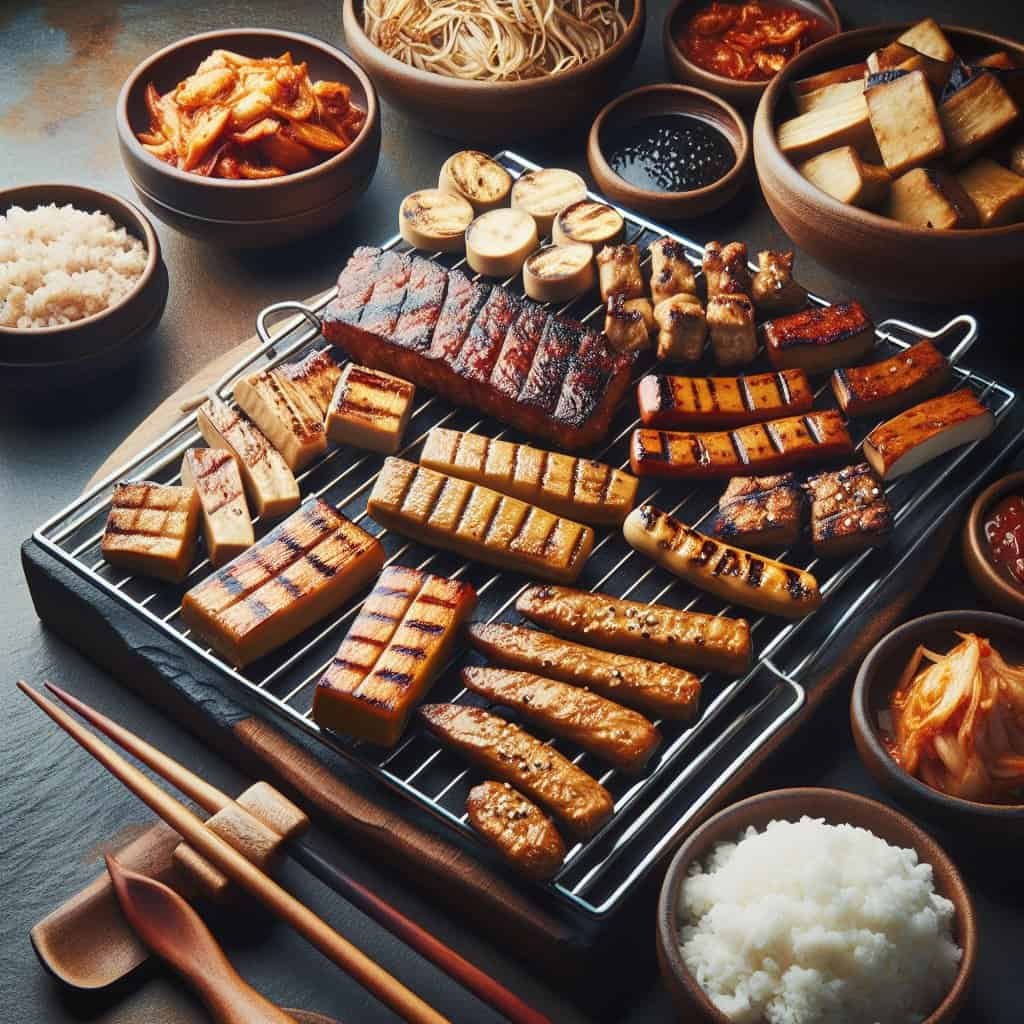Imagine sizzling plates of tender, juicy plant-based proteins, infused with the flavors of traditional Korean barbecue. As the world becomes increasingly conscious about sustainability and ethical eating, a fascinating trend has emerged in the culinary world. Chefs and food enthusiasts are experimenting with adapting traditional Korean barbecue techniques to create mouthwatering plant-based alternatives. From marinating and grilling to perfecting the art of banchan (Korean side dishes), this article explores how these adaptation efforts are revolutionizing the way we enjoy Korean barbecue while embracing a more environmentally friendly lifestyle. Get ready to embark on a flavorful journey that combines tradition with innovation!

Introduction
What is traditional Korean barbecue?
Traditional Korean barbecue, known as “gogi-gui” in Korean, is a popular dining experience in which patrons cook various meats, such as beef, pork, and chicken, at their table on a grill. It is characterized by its interactive and social nature, as well as the unique flavors and techniques used to prepare the meat.
Growing popularity of plant-based proteins
In recent years, there has been a significant rise in the popularity of plant-based proteins as more people embrace vegetarian and vegan lifestyles, or simply choose to reduce their consumption of meat. This growing trend has led to an increasing demand for plant-based alternatives in various cuisines, including Korean barbecue.
Need for adaptation of traditional techniques
While traditional Korean barbecue is primarily centered around meat, it is important for the culinary world to adapt and cater to the changing dietary preferences and needs of consumers. This requires innovative approaches to replicate the flavors, textures, and techniques of traditional Korean barbecue using plant-based proteins. By doing so, it allows vegetarians, vegans, and those looking to reduce their meat intake to enjoy the unique experience of Korean barbecue while still adhering to their dietary choices.
1. Expansion of Plant-Based Korean Barbecue
Introduction to plant-based proteins
Plant-based proteins are derived from sources such as legumes, soybeans, grains, and vegetables. They are rich in nutrients, lower in saturated fat, and can provide a comparable amount of protein as meat. Popular plant-based protein options include tofu, tempeh, seitan, and various meat substitutes made from soy or pea protein.
Rise of plant-based diets
Plant-based diets have gained popularity due to their potential health benefits, ethical considerations, and environmental sustainability. Many individuals are opting for a plant-based lifestyle as they become more aware of the impact of meat consumption on personal health and the planet. This shift in dietary choices has led to an increased demand for plant-based alternatives in a variety of cuisines, including Korean barbecue.
Demand for plant-based Korean barbecue
As people continue to explore plant-based diets, there is a growing demand for plant-based options in traditional Korean barbecue restaurants. Diners who are passionate about Korean cuisine and its unique flavors are now seeking plant-based alternatives that allow them to partake in the communal grilling experience while enjoying dishes that align with their dietary choices.
Influence of Korean cuisine on plant-based adaptations
Korean cuisine has a rich history of utilizing diverse vegetables, spices, and fermentation techniques to create bold and flavorful dishes. This has paved the way for innovative adaptations of traditional Korean barbecue techniques for plant-based proteins. By drawing inspiration from traditional Korean flavors and cooking methods, chefs are able to create plant-based barbecue options that are both delicious and reminiscent of the original meat-based dishes.

2. Understanding Traditional Korean Barbecue Techniques
Brief overview of traditional Korean barbecue
Traditional Korean barbecue involves grilling various cuts of meat at the table on a charcoal or gas grill. The meat is often marinated beforehand to enhance its flavor and tenderness. Diners typically accompany the grilled meat with an array of side dishes, including kimchi, pickled vegetables, and rice.
Focus on grilling and marinating techniques
Grilling is a fundamental technique in Korean barbecue, as it imparts a smoky and charred flavor to the meat. The meat is cooked over high heat, resulting in a caramelized exterior and a juicy interior. Marinating is another crucial step in traditional Korean barbecue, as it tenderizes the meat and infuses it with flavors from ingredients such as soy sauce, garlic, ginger, and sesame oil.
Role of meat in the traditional Korean barbecue
Meat plays a central role in traditional Korean barbecue, as it is the main ingredient that is grilled and savored. The flavors and textures of the meat are greatly valued, and the communal grilling experience brings people together to enjoy the unique flavors and aromas that are a hallmark of Korean barbecue.
Flavors and spices traditionally used
Traditional Korean barbecue is known for its bold and vibrant flavors. Garlic, ginger, soy sauce, sesame oil, and gochujang (a spicy fermented pepper paste) are commonly used to marinate the meat, infusing it with a rich umami taste. These flavors, combined with the smoky and charred notes from the grilling process, create a unique and memorable dining experience.
3. Challenges in Adapting Techniques for Plant-Based Proteins
Textural differences between meat and plant-based proteins
One of the main challenges in adapting traditional Korean barbecue techniques for plant-based proteins is replicating the textural qualities of meat. Meat has a unique combination of moisture, tenderness, and chewiness that is not easily replicated by plant-based alternatives. Achieving a similar texture in plant-based proteins requires innovative techniques and the use of ingredients such as mushrooms, wheat gluten, or soy protein isolates.
Marinating plant-based proteins for flavor absorption
Marinating is an essential step in traditional Korean barbecue, and ensuring that plant-based proteins can absorb and retain flavors is crucial. Plant-based proteins have a different texture and composition compared to meat, which can affect the marinade’s ability to penetrate and flavor the protein properly. Chefs and food scientists are experimenting with different marinades and techniques to enhance the flavor absorption of plant-based proteins.
Ensuring desired smoky and charred flavors
The smoky and charred flavors that are characteristic of traditional Korean barbecue are achieved through the grilling process. However, plant-based proteins can have different cooking requirements and may not develop the same smoky and charred flavors as meat. Chefs are exploring various cooking methods, including using high-heat grills, smoking techniques, or adding ingredients like liquid smoke, to replicate these desirable flavors in plant-based Korean barbecue.
Overcoming perception differences between meat and plant-based barbecue
Many diners have preconceived notions about the taste and experience of traditional Korean barbecue, which often revolve around the consumption of meat. Adapting these techniques for plant-based proteins requires overcoming these perceptions and showcasing the delicious and satisfying flavors that can be achieved. Educating and introducing diners to well-executed plant-based Korean barbecue options can help dispel any doubts and encourage acceptance of these adaptations.

4. Techniques for Adapting Korean Barbecue for Plant-Based Proteins
Grilling techniques for plant-based proteins
Adapting grilling techniques for plant-based proteins involves finding the right balance between achieving a charred exterior while maintaining a moist and tender interior. Chefs may experiment with adjusting cooking times, using certain cooking surfaces, or incorporating ingredients that enhance moisture retention, such as plant-based fats or oils.
Alternative marinades for plant-based proteins
To ensure that plant-based proteins are well-marinated and flavorful, alternative marinades can be used. Chefs can explore different combinations of spices, herbs, fermented sauces, and umami-rich ingredients to create marinades that complement the flavors of plant-based proteins. This allows the proteins to absorb and retain the desired flavors, resulting in a delicious and satisfying barbecue experience.
Incorporating smoky and charred flavors without meat
To achieve smoky and charred flavors in plant-based Korean barbecue, chefs can employ various methods such as using liquid smoke, grilling on charcoal or wood-fired grills, or incorporating ingredients that provide a distinct smoky taste. Additionally, techniques like broiling or using a blowtorch can help create the desirable charred exterior that adds depth and complexity to the dish, even without the presence of meat.
Adding depth and umami to plant-based barbecue
Plant-based proteins can sometimes lack the depth and richness of umami flavors found in meat. To address this, chefs can incorporate ingredients such as fermented soy products (e.g., miso or fermented bean pastes), dried mushrooms, and seaweed-based seasonings to enhance the umami profile of plant-based barbecue. These ingredients contribute to a more complex and satisfying taste that closely resembles the flavors of traditional Korean barbecue.
5. Innovations in Plant-Based Korean Barbecue
Use of plant-based meat substitutes in Korean barbecue
The expanding market for plant-based meat substitutes has allowed chefs to create more authentic Korean barbecue experiences using plant-based proteins. With advancements in food science, plant-based meat substitutes now closely mimic the texture and flavor of various cuts of meat. Incorporating these substitutes into traditional Korean barbecue allows for a diverse range of plant-based protein options and satisfies the cravings of both meat eaters and vegetarians alike.
Creative plant-based protein options
In addition to meat substitutes, there are also numerous creative plant-based protein options that can be utilized in Korean barbecue. These include marinated tofu, seitan, tempeh, and various vegetable-based proteins such as mushrooms or jackfruit. These alternatives provide an array of textures and flavors that can be grilled and enjoyed in traditional Korean barbecue settings.
Hybrid BBQ dishes blending meat and plant-based proteins
To cater to the preferences of diverse diners and bridge the gap between meat-based and plant-based diets, some restaurants are offering hybrid BBQ dishes that incorporate both traditional meat and plant-based proteins. This allows carnivorous diners to enjoy their favorite cuts of meat while also providing plant-based options for those who prefer them. By offering a variety of choices, restaurants can cater to a wider range of dietary preferences and create a more inclusive dining experience.
Environmental and health benefits of plant-based adaptations
The adaptation of traditional Korean barbecue techniques for plant-based proteins not only caters to changing dietary preferences but also has significant environmental and health benefits. Plant-based proteins have a lower carbon footprint and require fewer natural resources to produce compared to animal-based proteins. Additionally, opting for plant-based barbecue options can potentially lead to lower cholesterol levels, reduced saturated fat intake, and improvements in overall health and well-being.

6. Plant-Based Korean Barbecue Restaurants and Chefs
Emergence of plant-based barbecue restaurants
As the demand for plant-based options continues to grow, a new wave of plant-based Korean barbecue restaurants is emerging. These establishments focus on crafting innovative plant-based barbecue experiences that closely mimic the traditional flavors and techniques of Korean barbecue. By offering a wide selection of plant-based proteins and creative adaptations, these restaurants provide a welcoming space for plant-based eaters and those seeking to explore new culinary horizons.
Chefs specializing in plant-based adaptations
Chefs who specialize in plant-based adaptations of traditional Korean barbecue techniques play a crucial role in driving the innovation and creativity within this niche. These talented individuals experiment with ingredients, techniques, and flavors to create plant-based dishes that are both delicious and memorable. Their expertise and passion contribute to the growth and development of the plant-based Korean barbecue movement.
Farm-to-table approach in plant-based Korean barbecue
Many plant-based Korean barbecue restaurants embrace a farm-to-table approach, sourcing fresh and locally sourced ingredients. This ensures the highest quality of produce and supports local farmers. By prioritizing the use of seasonal vegetables and sustainable practices, these restaurants contribute to a more environmentally conscious and ethical dining experience while celebrating the flavors and techniques of plant-based Korean barbecue.
Incorporating traditional Korean flavors in plant-based dishes
While plant-based Korean barbecue may deviate from traditional meat-centered dishes, chefs are finding ways to incorporate familiar and beloved Korean flavors into their plant-based creations. With a focus on ingredients such as soy sauce, gochujang, sesame oil, and traditional spices, these chefs are able to offer plant-based dishes that pay homage to the rich culinary heritage of Korea while accommodating dietary preferences.
7. Reactions and Feedback from Consumers
Consumer perceptions of plant-based Korean barbecue
The reactions and perceptions of consumers towards plant-based Korean barbecue have been diverse. Some individuals may initially approach these adaptations with skepticism or hesitation, particularly if they have strong ties to traditional meat-based barbecue. However, as more people become educated about the environmental and health benefits of plant-based diets, along with the growing availability and quality of plant-based protein options, consumer perceptions are gradually shifting in favor of embracing plant-based adaptations of Korean barbecue.
Acceptance and popularity of adaptations
Despite initial reservations, there has been a growing acceptance and popularity of plant-based Korean barbecue among consumers. Many are pleasantly surprised by the flavors, textures, and overall experience provided by these adaptations. The ability to enjoy a communal dining experience, coupled with the familiar flavors of Korean barbecue, has resonated positively with both plant-based eaters and meat lovers looking to explore alternative options.
Comparisons to traditional meat-based barbecue
While plant-based adaptations of Korean barbecue strive to replicate the flavors and techniques of traditional meat-based barbecue, there will inevitably be differences between the two experiences. Some consumers may prefer the flavors and textures unique to meat, while others appreciate the lighter and healthier attributes of plant-based alternatives. Ultimately, the success of plant-based Korean barbecue lies in its ability to provide a delicious and satisfying dining experience for all, regardless of dietary preferences.
Integration of plant-based options into traditional Korean barbecue restaurants
As the demand for plant-based options grows, many traditional Korean barbecue restaurants are taking steps to integrate plant-based alternatives into their menus. This allows these establishments to cater to a wider range of customers who seek diverse dining options. By offering plant-based proteins alongside traditional meat options, restaurants can create a more inclusive and accommodating environment that welcomes diners with varying dietary choices.

8. International Influence and Expansion
Global interest in plant-based Korean barbecue
The popularity of plant-based adaptations of Korean barbecue is not limited to Korea alone. With the rise of plant-based diets worldwide, there is a growing interest in exploring and experiencing diverse cuisines in plant-based form, including Korean barbecue. This global interest has sparked the expansion of plant-based Korean barbecue options in various countries, where both locals and visitors can indulge in the unique flavors and techniques of this beloved culinary tradition.
Adaptation and fusion with other international cuisines
Plant-based Korean barbecue is not only influencing global perceptions of Korean cuisine but also inspiring chefs to create innovative fusion dishes. By incorporating elements from other international cuisines, such as Mexican, Mediterranean, or Indian, chefs are expanding the culinary possibilities of plant-based Korean barbecue. These exciting fusions introduce new flavors and textures, providing diners with an enhanced dining experience that reflects the diversity of the contemporary culinary landscape.
Growth of plant-based Korean barbecue outside Korea
With the growing popularity of plant-based diets and Korean cuisine, plant-based Korean barbecue is making its mark outside Korea. Restaurants and food establishments in various countries are starting to embrace these adaptations and offer plant-based Korean barbecue options to cater to the evolving tastes and needs of customers. This expansion not only provides more choices for plant-based eaters but also introduces new audiences to the vibrant and unique flavors of Korean barbecue.
Influence on other Asian and Western barbecue traditions
The innovation and adaptation of traditional Korean barbecue techniques for plant-based proteins have the potential to influence other Asian and Western barbecue traditions as well. Chefs worldwide are exploring ways to incorporate plant-based proteins into their own barbecue dishes, drawing inspiration from the techniques developed in plant-based Korean barbecue. This cross-pollination of ideas promotes creativity and encourages the growth of more inclusive and sustainable dining options globally.
Conclusion
Summary of the adaptation of traditional Korean barbecue techniques
The adaptation of traditional Korean barbecue techniques for plant-based proteins has opened up exciting possibilities for both chefs and consumers alike. By utilizing innovative cooking methods, alternative marinades, and creative plant-based protein options, chefs are able to recreate the flavors and textures of traditional Korean barbecue while catering to the preferences of plant-based eaters.
Growing importance of plant-based proteins
As plant-based diets gain popularity, the importance of incorporating plant-based proteins into diverse culinary traditions becomes evident. The adaptation of traditional Korean barbecue techniques for plant-based proteins not only meets the demands of consumers but also highlights the versatility and sustainability of plant-based proteins.
Exciting possibilities for the future
The future of plant-based Korean barbecue is promising, with ongoing innovation and advancements in plant-based protein alternatives. As consumer preferences continue to evolve, chefs and restaurants will likely explore new flavors, techniques, and dining experiences to provide innovative plant-based Korean barbecue options. With environmental sustainability in mind and a focus on celebrating the rich culinary heritage of Korea, plant-based Korean barbecue is set to flourish and captivate the taste buds of both plant-based eaters and enthusiasts of Korean cuisine around the world.
